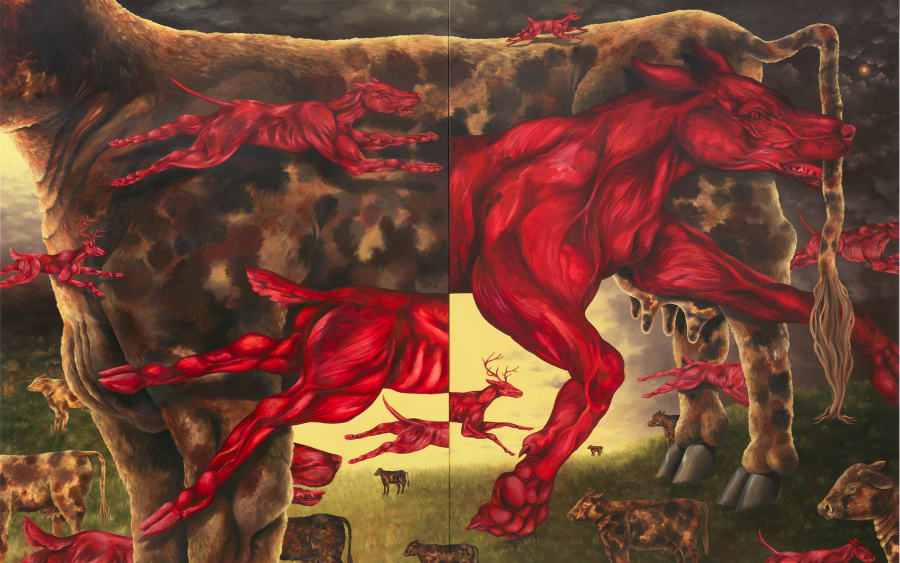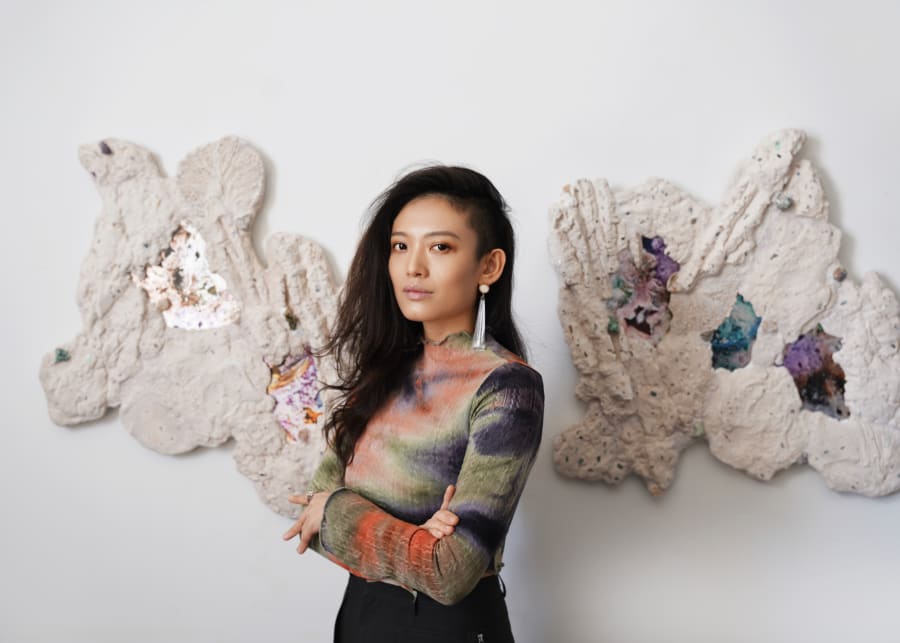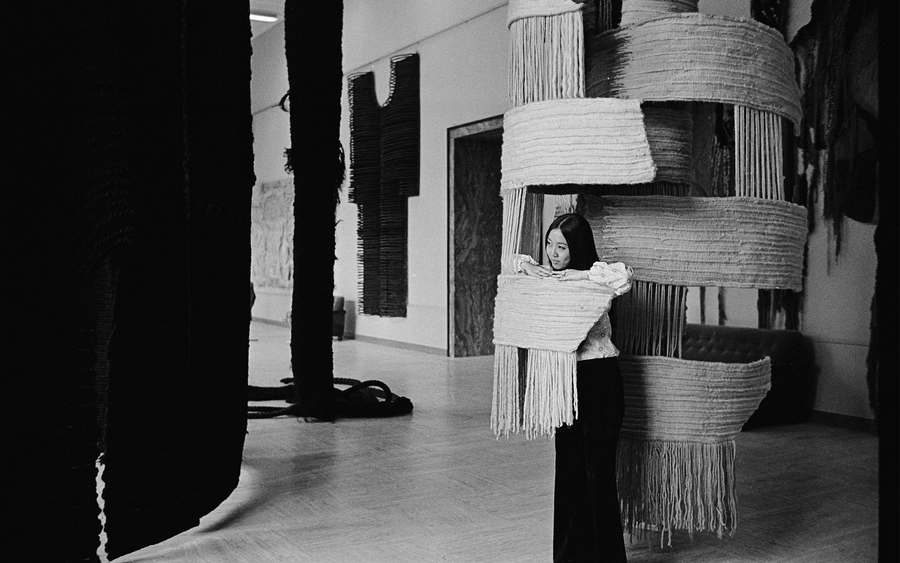When the world’s first portable video camera, the Sony Portapak, was launched in the late 1960s, it became possible for individuals to film everywhere. The democratization of video dovetailed with avant-garde art movements that emphasized the use of everyday tools and actions to create unconventional artworks, while coinciding with the burgeoning women’s movement. Little surprise, then, that among the pioneering video artists of the 1970s and 1980s were influential female figures who expanded the early possibilities of the field.
One of those artists was Shigeko Kubota (1937-2015), who was a key figure in the Fluxus scene. Finding limited success in her native Japan, Kubota moved to New York in 1964. She created her famous Vagina Painting performance a year later, in which she tied a paintbrush dipped in red to her underwear, squatted, and dragged it around a canvas on the floor. The link to menstrual blood reinstated the primacy of the female body and its reproductive power, and subverted the view of women as passive subjects in art.
In the 1970s, Kubota’s experimentations with the Sony Portapak began a lifelong commitment to video and new media. Although her work drew on different themes and ideas, many of them took the form of ‘video diaries,’ through which she documented personal and artistic journeys. Kubota added text or voiceovers to these videos, and integrated early visual effects technologies such a chroma keying (layering two or more video streams together based on color hues) and colorizing (a process that adds color to monochrome moving-picture images). She also pioneered the medium of ‘video sculpture’: three-dimensional creative assemblages made of plywood, sheet metal or plastic containing video screens. The brand of the monitors was obscured to decouple associations with mainstream television while challenging the notion that video art was ephemeral and insubstantial.
One of Kubota’s definitive works is Video Poem (1970-75), made during her studies at the California Institute of the Arts with video engineer Shuya Abe, and subsequently re-edited a few years later. Kubota is filmed interacting with her close-up video self-portraits, and manipulates the electronic signal to create new colors and patterns. The video is played on a monitor enveloped in a zipper bag with a small fan, so that Kubota’s face appears to peer out of the bag.
Although Kubota did not characterize herself as a feminist, her works frequently drew explicit links between video art and the power of femininity. Included in texts accompanying Video Poem are her iconic lines: ‘Video is Vengeance of Vagina. / Video is Victory of Vagina.’
Video provided the freedom for other female artists to explore conceptual experimentations, such as the Korean-born, France-based Kim Soun-Gui (b. 1946), who saw multimedia art as a way of interacting with the world authentically and spontaneously. Trained in calligraphy and traditional Korean archery, she completed her art studies in Seoul National University in 1971 before moving to Nice to study at the École Nationale d'Arts Décoratifs de Nice. In France, she began to combine art and technology in expansive ways, and created video recordings of her Situation Plastique participatory performance and installation pieces in the early 1970s, including Plastique II (1971–73), where participants made kites and flew them. Later, she collaborated with artists and thinkers like John Cage and Nam June Paik, who were among the participants in the festival Kim organized in 1986 in Marseilles, ‘Video & Multimedia: Soun-Gui Kim and her invitees’.
An abiding influence on Kim’s work is Taoism. She is fascinated by the idea of the ‘holistic brushstroke,’ advocated by Shitao, a master ink painter and calligrapher from the early Qing dynasty in China. Shitao argued against the prevailing aesthetic norm of his time, that art was about mastering a set of techniques; instead, art was something primal and free from convention, and the artist should be able to show the universe in one profound line that integrates mind, body, brush, and ink. Kim saw parallels between the holistic brushstroke and the martial art of archery. In the video Ten Thousand Ugly Ink Dots (1982), the artist expressed that link in a performance in which she shoots an arrow at a dot painting, fusing two notions of mark-making.
Other than being a time-based medium that allows for metaphysical enquiry, video has also been harnessed to make complex, multimedia work with immersive environments and richly layered narratives. This is illustrated by Nalini Malani (b. 1946), who uses video as a key element in what she terms ‘video/shadow plays’; sensorial environments that incorporate painting, drawing, installation, projection, film, and animation.
Malani was born in Karachi a year before the creation of the modern state of Pakistan. Her family fled as refugees into India, and Malani settled in Bombay (current-day Mumbai), where she has lived and worked since 1958. The experience of displacement would form her lifelong commitment to investigating the effects of war and the dangers of fundamentalist thinking. Trained in classical painting at the Sir J.J. School of Art, she initially focused on painting (acrylic on canvas and watercolor on paper), portraying life in contemporary India, with a focus on gender and family issues. Drawing and painting would remain hallmarks of her practice; even as she moved into multimedia installations, her drawings are frequently used as projected animations.
Between 1969 and 1971, Malani was a member of the Vision Exchange Workshop, an interdisciplinary workshop for creatives working across different media, including animation, sculpture, and printmaking. There, she was introduced to film, and in 6 months, made three 8 mm and 16 mm films, including Dream Houses (1969), an abstract work inspired by Modernist Indian architecture. Over the years, Malani’s work became more ambitious in its technical complexity, with multimedia installations often taking the form of monumental and immersive shadow-play pieces that generate dynamic layers of imagery and sound.
A committed social activist, Malani has spoken out against nationalism, sectarianism, and violence against women. The video installation Unity in Diversity (2003), for example, responds to the 2002 riots in Gujarat between Hindus and Muslims, which involved a campaign of violent rape against Muslim women. The work mimics a middle-class Indian sitting room with red walls, where a large painting – actually a video in a gilded frame – comes to life. The video is based on the 19th-century Indian painting Galaxy of Musicians (1889) by Raja Ravi, which depicts 11 female musicians from different parts of India, dressed in their respective regional costumes and playing in harmony. In Malani’s video, the performance morphs into a bloodbath, interspersed by gunshots and screams, and the images of the orchestra transform into an army of women carrying rifles for self-protection.
Malani is known for her use of clear Mylar cylinders, which are hand-painted with cultural and historical iconography and hung from the ceiling. Rotated by a motor, they evoke the meditative calm of Tibetan Buddhist prayer wheels, while light projected onto them creates a slow play of images on the wall reminiscent of lantern slide presentations. Layered over these light-and-shadow effects is more original video footage. A seminal work in this vein is In Search of Vanished Blood (2012), comprising five reverse painted rotating cylinders and six video projections with sound. Touching on the condition of women in India, and on a broader level, our alienation from our bodies and each other, the work draws from a wide range of source material, including images from Greek and Hindu mythology. Enigmatic images are layered into rapidly moving visual narratives, from architectural forms and cloudy skies to world maps and human faces, to create a rich sensorial and kaleidoscopic environment.
Malani once said: ‘I don’t consider myself to be a filmmaker but I use video as a painter would.’ Her use of video as a tool for advocacy and self-expression has parallels with the spirit of Kubota and Kim, whose daring explorations pioneered the aesthetic and political possibilities of the medium in the 20th century.
Shigeko Kubota is represented by Fergus McCaffrey (Paris, Tokyo) and Galerie Hubert Winter (Vienna).
Kim Soun-Gui is represented by Arario Gallery (Shanghai, Cheonan, Seoul).
Nalini Malani is represented by Vadehra Art Gallery (New Delhi), Lelong Editions (Paris), Galerie Lelong & Co. (Paris, New York) and Arario Gallery (Shanghai, Cheonan, Seoul).
All three artists will be on view at Art Basel Hong Kong 2024.
Adeline Chia is an arts writer and editor based in Singapore.
Caption for the full-bleed image: Kim Soun-Gui, Ten Thousand Ugly Ink Dots (still), 1982. Courtesy of the artist and Arario Gallery.


